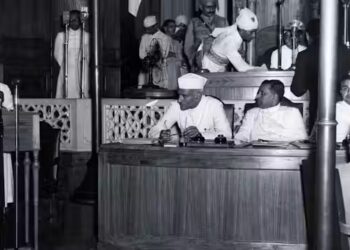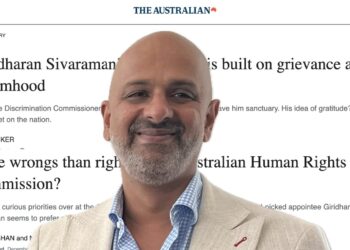Religious freedom isn’t merely the freedom to practice one’s faith. The true test is whether a government is abiding by its constitutional duty to not favour any one religion over the others.
I was recently in a talk show along with three other panelists on TV Asia’s “Bottom Line with Jyotsna Sharma.” The topic was Religious Freedom in India – Challenges of Pluralism.
The discussion touched on the Citizenship Amendment Act (CAA), cow slaughter bans and lynchings, religious conversions, so-called uniform civil code, resolutions by U.S. cities on India, and the California textbook controversy (view the full show here).
As the host noted, it was perhaps the first time that two Hindu groups with contrasting views were appearing on the same platform.
The other group, represented by Arvind Kumar, was CAPEEM, formed in 2006 to challenge the contents of California’s Sixth-grade History-Social Science textbooks. CAPEEM, considered to be aligned with Hindutva, had sued the state twice and lost both times.
I was glad that the host brought up the textbook controversy, as it is an excellent lens through which to view the double standards of Hindutva ideology on religious freedom.
Trojan Horse for Hindutva History
The crux of the textbooks debate in 2006 were extensive edits demanded by two groups, the Hindu Education Foundation (HEF) and the Vedic Foundation (VF), and the ensuing opposition to them by South Asian scholars and community groups.
HEF and VF were clearly riding on the backs of genuinely concerned Hindu parents to inject a Hindutva version of history into the curriculum: e.g., claiming that caste has nothing to do with Hinduism; demanding that the word ‘caste’ be changed to ‘class’; seeking to erase Dalit identity; pushing the ‘Aryans were indigenous to India’ theory; etc.
As a California parent, I was put off by the very notion that parents should seek changes to history books to shield their children from unpleasant topics like caste. Their efforts had seemed to me akin to white parents agitating against teaching the history of slavery, lest it embarrass their children. (See History or Hysteria – a parent’s response to the Hindu American Foundation.)
Who can forget the images of Prime Minister Modi presiding over the Bhoomi Pujan of the proposed Ram temple, an event beamed across the world like an official state event of the government?
VF had also surprisingly objected to factual statements that Hindus consider cows as sacred and that Ganga jal (water from the river Ganga) is often kept in Hindu homes.
VF’s spiritual leader Prakashanand Saraswati was known for touting his book, “The True History and the True religion of India,” in which he condemns secular academic history and declares that only “eternal saints” can be authorities on history. Among his claims was that the history of India is 155.521972 trillion years old!
As it happened, he was found guilty in 2011 of 20 counts of indecency with a child and fled the country before sentencing.
The Establishment Clause at Play
CAPEEM sued the State Board of Education (SBE) in 2006 claiming that it had violated the establishment clause of the constitution (i.e. government neutrality towards religions), by “embracing Judeo-Christian conceptions of Divinity to the exclusion of other conceptions” and portraying Hinduism “inaccurately” and “in a negative light” compared to other religions.
In 2009, a Federal District Court dismissed CAPEEM’s claims and reproved its “bald assertion” and “self-serving statements.” In his ruling, U.S. District Judge Frank C. Damrell, Jr, wrote:
“…plaintiff [CAPEEM] offers no authority whatsoever in support of its bald assertion that it can satisfy the germaneness requirement for this claim…Such self-serving statements…are insufficient to meet plaintiff’s burden…CAPEEM’s allegations regarding the indoctrination by the textbooks [into Christian and Jewish religions] … represents a mere ‘generalized grievance’ that any citizen might attempt to litigate simply because he or she takes offense at the textbooks.”
In 2017, CAPEEM sued once again on similar grounds. And, once again, the District Court dismissed the key charges, a ruling later upheld by the U.S. Court of Appeals: “But even if isolated passages could be read as implying some hostility toward religion—which they do not—they would not violate the establishment clause unless that were the principal or primary effect.”
Sadly, despite its rebuff by the courts, CAPEEM seems to exult in anti-minority conspiracy theories — among them, that the U.S. government is using Muslims and Christians to attack Hindus. In his combative performance on the show (view the full show here), Arvind Kumar seemed to attribute racist motives to the courts. Most importantly, he dismissed all questions on religious freedom in India with his unqualified support for the politics of RSS/BJP.
As a concerned California parent and a grandparent, I am compelled to ask, “Which is the real face of organizations like CAPEEM?”
Is it the one that had argued for government neutrality towards religion in California textbooks, or the one that is embracing a majoritarian Hindu government in India, which is behaving as if Hinduism is the state religion and the minorities are second class citizens?
Who can forget the images of Prime Minister Modi presiding over the Bhoomi Pujan of the proposed Ram temple, an event beamed across the world like an official state event of the government?
Hindus for Human Rights (HfHR) and others were at New York’s Times Square on that day, protesting the naked triumphalism associated with the event, which was a tragic culmination of years of destruction and death in the name of Hindus and Lord Rama.
A Clear Moral Choice
A recent Pew Research Center survey reported that more than 80 percent of Indians believe that respect for all religions lies at the core of their identity as Indians. That is an encouraging sign, notwithstanding the fact that Indian society is still highly fragmented along religious and caste lines.
However, the real question is whether the government‘s policies and actions are consistent with the belief of that overwhelming majority?
The answer, unfortunately, is an emphatic no!
Today, it seems as if the Modi/Shah regime has thrown all constitutional guarantees on freedom of religion and freedom of expression to the wind, in pursuit of a majoritarian Hindu Rashtra.
Hundreds of people have been killed, maimed, and incarcerated on false charges as a direct result of state policy directed against religious minorities, in the name of all Hindus. And despite active resistance by citizen groups and censures by international human rights and diaspora Indian groups, the ruling class continues to escalate its triumphal and divisive sectarian agenda with impunity.
In another survey by the Carnegie Endowment, over 53% of Indian Americans (40% of Hindu Americans) said that they believe that India is on the wrong track. That too is a hopeful sign in that most people seem to recognize the imminent dangers to Indian democracy.
The real question today is whether that majority of Indian Americans, especially Hindu Americans, will summon the will to condemn Hindutva-aligned groups in their midst for their support of the BJP/RSS rule, which has abandoned its constitutional duty to stay equidistant from all religions.
The epic Ramayana talks about how Hanuman, the foremost devotee of Lord Rama, underestimated his own strength at critical times, until others prodded him into action. Perhaps, Hindu Americans too need to be reminded at this point of their enormous potential clout, which can and should be urgently deployed to reclaim Indian democracy.

Raju Rajagopal is a co-founder of Hindus for Human Rights, an advocacy organisation dedicated to human rights of all communities in India and the U.S. Details at www.hindusforhumanright.org. The above views are personal.
This article was first published in American Kahani.











